Adios Mexico
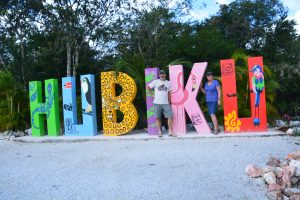
The large coloured letters at all the sites in Mexico have been a real hit – and I think this is the last one!
We got off our plane in Cancun from Havana and passed through Customs and Immigration, a little anxious about what we would find out in the carpark. We had left Tramp in as safe a position as possible and hoped he would not be the victim of any foul play while we were living it up in Cuba. But there he was, safe and sound, wagging his tail when he saw us, all good. We piled back in, happy to be home again, and headed off to a nearby campground we had used before. We only had a few more days in Mexico but we still had a lot of places we wanted to go. As they say, vamonos!
Our plan was to head south and cross over into Belize within a day or so…but wait…we got talking to a Canadian who had lived in Cancun for 17 years and he started telling us of other great spots – to the north! So after a morning of doing washing and swapping out our finicky water pump with the spare that we had brought we headed north along some narrow secondary roads through a string of small Mayan villages until we reached the northern beaches of the Yucatan Peninsula on the Gulf of Mexico right at dusk. We camped on a salt flat behind some sand dunes only steps away from the surf, built a fire and enjoyed a beautiful spot to end the day.
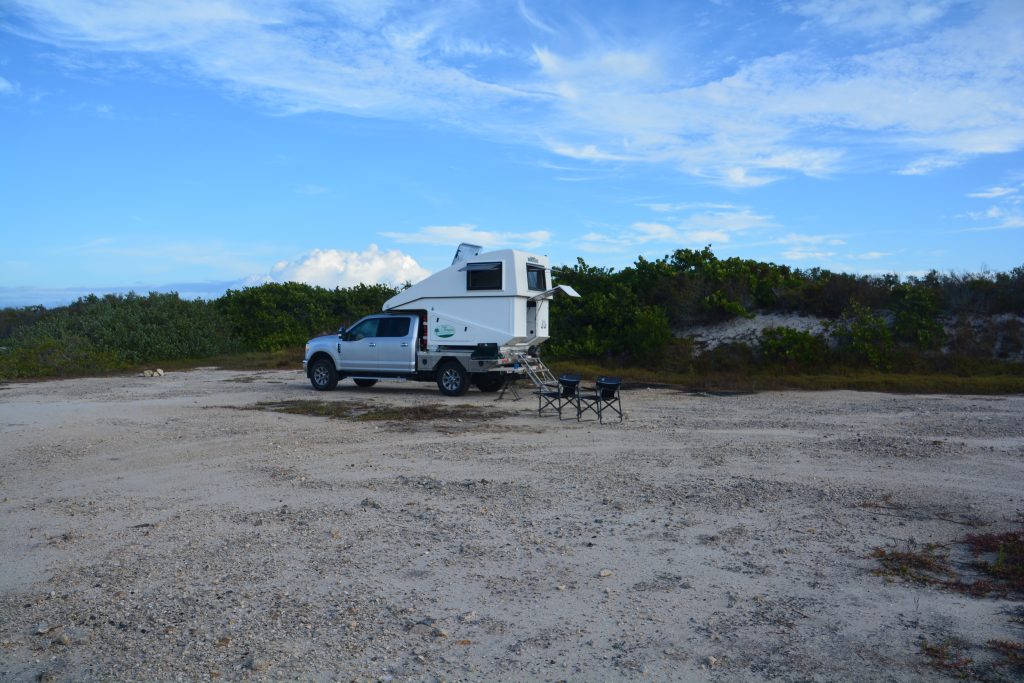
This fabulous campsite with the surf behind us and the flamingos in the lagoon in front of us got a rare rating of 10
But why so far out of our way? In one word, flamingos. The shallow and salty lagoons that sit behind a row of protective sand dunes are the home to hundreds, sometimes thousands, of flamingos, depending on the season. The area also has some first-class Mayan ruins to see and a fabulous cenote to swim in.
We woke the next morning to a stunning sunrise on the beach and a small flock of elegant pink flamingos feeding in our private lagoon. These graceful birds with their long legs and even longer bendy neck walk in the shallow water and feed on little goodies at their feet. They were great fun to watch, sometimes in pairs, sometimes in a larger group, sometimes a small flock flying low overhead. Flamingos rock!
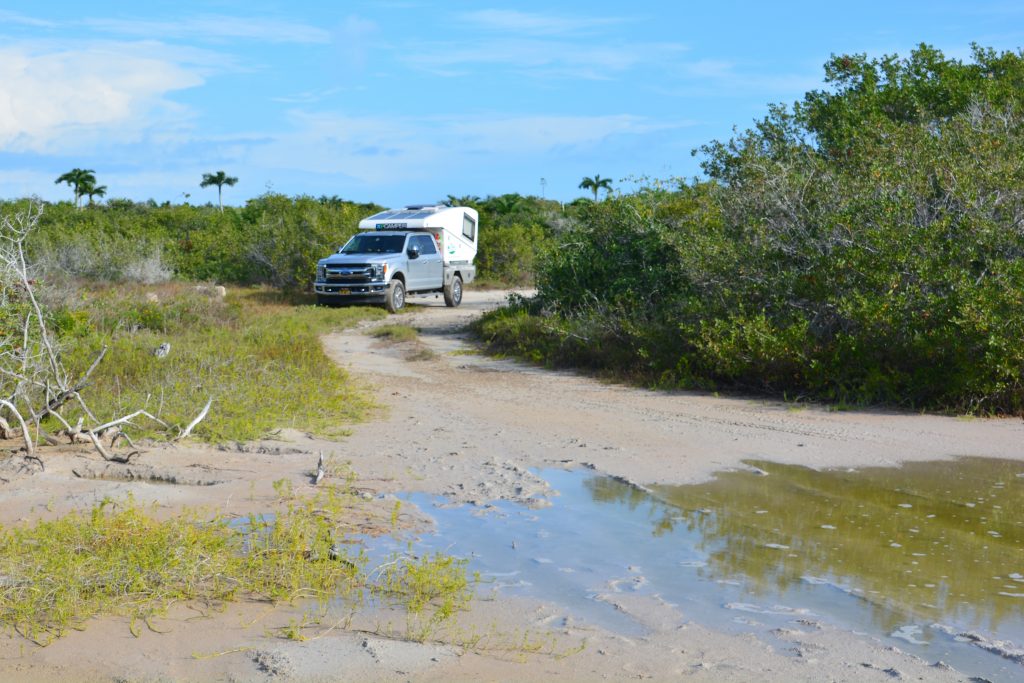
But flamingo hunting was hard work for Tramp and he got himself in a couple of tight muddy situations during the morning
After exploring these shallow salt flats for more flamingos, and there were plenty of them, we headed up to the town of Rio Lagartos, a small fishing town which tourists visit to see the flamingos. We dragged the promenade as the sun developed a serious bite and then headed south to the Mayan ruins of Ekbalam.
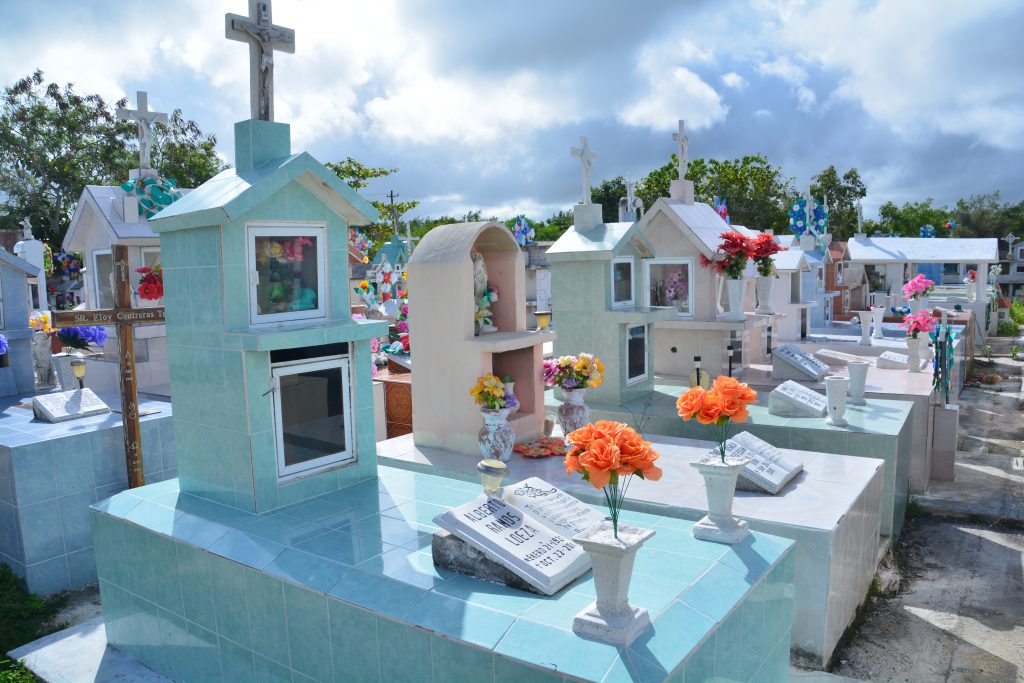
Mexicans know how to do cemeteries and this one near Rio Lagartos shows off the best features – an above ground crypt, fresh paint, bright colours, plastic flowers and an enduring feeling of remembrance
Ekbalam had been recommended to us because of the impressive ruins and the fact they are relatively quiet because very few tourists visit them. We enjoyed wandering amongst the buildings, especially the well-preserved ball court, and climbed up the steep stairs of the acropolis and pyramid to get grand views of the buildings and the thick jungle all around us. Ekbalam isn’t in the same class as Uxmal or Chichen Itza but we still enjoyed our visit, despite the stifling heat. Thank goodness we visited in winter instead of summer!
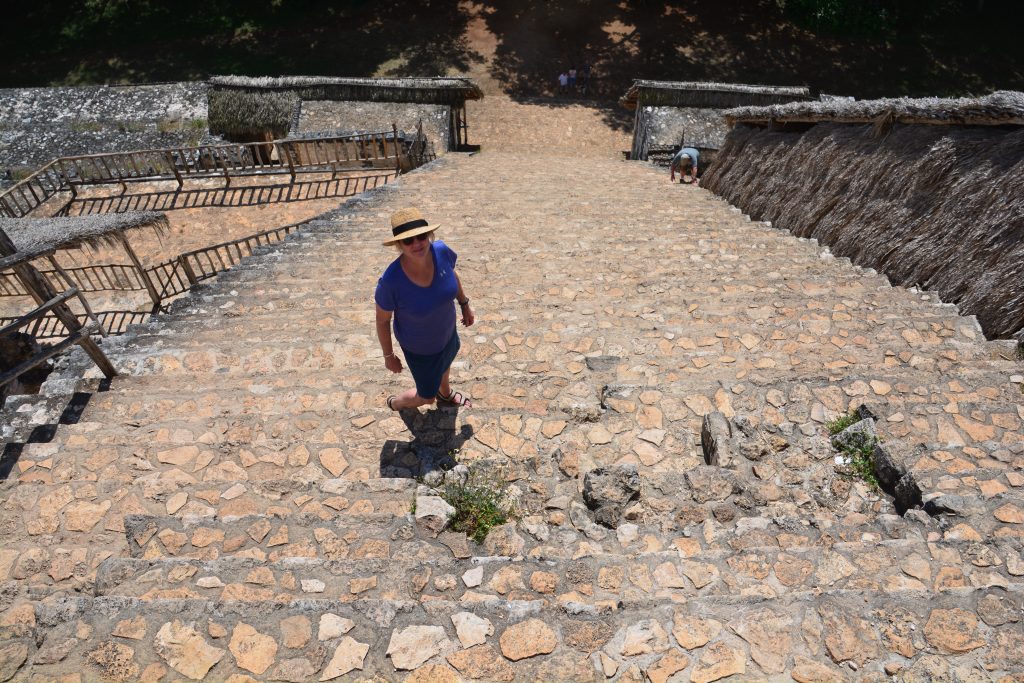
The main pyramid of these ruins was seriously steep – as steep as we’ve seen anywhere – and required careful negotiation both up and down (see the guy lower down doing it on all fours)

Ekbalam is in an obscure place and not in the same class as Uxmal or Chichen Itza but we still rated it highly
Our next stop was the Hubiku cenote, a perfect antidote to the heat. A cenote is deep hole in the ground caused when the roof of a limestone cave collapses, revealing a cavern which fills with water. They are common in the Yucatan and many of the best ones have been turned into tourist attractions. We followed the steps through a little tunnel to the base of this cenote and dived into the cold clear water that formed a dark bottomless swimming hole. Water sprinkled down with a stream of sunlight from the hole in the top of the cenote, creating sort of an underground garden of eden feeling.

The water was a bit cool but the whole experience was fabulous. The little black things in the water are fish
Julie and I had a good long swim, cooling down and cleaning off while marvelling at this amazing naturally formed underground pool, then reluctantly headed south along some boring toll roads until we hit the uber-crowded holiday resort town of Playa del Carmen. The crowded streets and hectic traffic were a bit of a shock to our system after such a beautiful and peaceful day up north but we needed to do a major resupply of the fridge and pantry before finding a place to camp. But by this time it was dark and pouring with rain…so it was that after 248 days of camping we finally succumbed to the ultimate back-up plan – camping in the Walmart carpark. A unique experience it was!
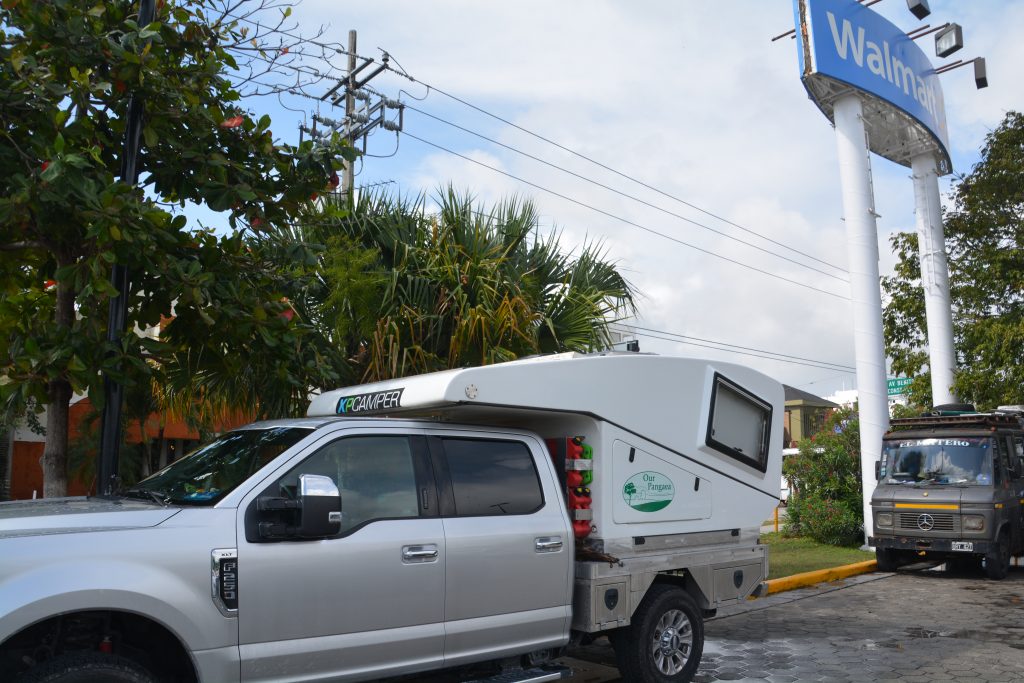
OMG, we said we would only do this if there was absolutely no other choice but that’s where we reluctantly found ourselves in Playa del Carmen
South of Playa del Carmen lies Tulum, one of the most renowned sites of the ancient Mayan empire. We arrived at Tulum after a night of heavy rain and lingering grey clouds but spent two hours at the site without getting wet. Tulum is unique in all the Mayan cities we’ve visited in that it was built high on a cliff overlooking the turquoise waters of the Caribbean Sea and its inhabitants from 1200 to 1500 lived inside and outside its massive walls on fish and other treats from the sea as well as what they could grow and find in the jungle.

Who wants to live in the deep humid jungle when you can live on the coast, enjoy the breezes and eat fish?
We have been spoiled by visiting these ancient sites in the morning before the tour buses arrived but not so at Tulum – we were there in peak group tour time and despite the beautiful setting some of the gloss was unfairly taken off our visit. Tulum was one of the last Mayan cities to fall when the Spanish arrived in the early 16th century and its great location marks a sharp contrast to the pre-Aztec city of Teotihuacan out in the hot dusty desert or the Mayan jungle cities of Uxmal or Chichen Itza. If we had to choose an ancient Mayan city to live in we would choose Tulum hands down.
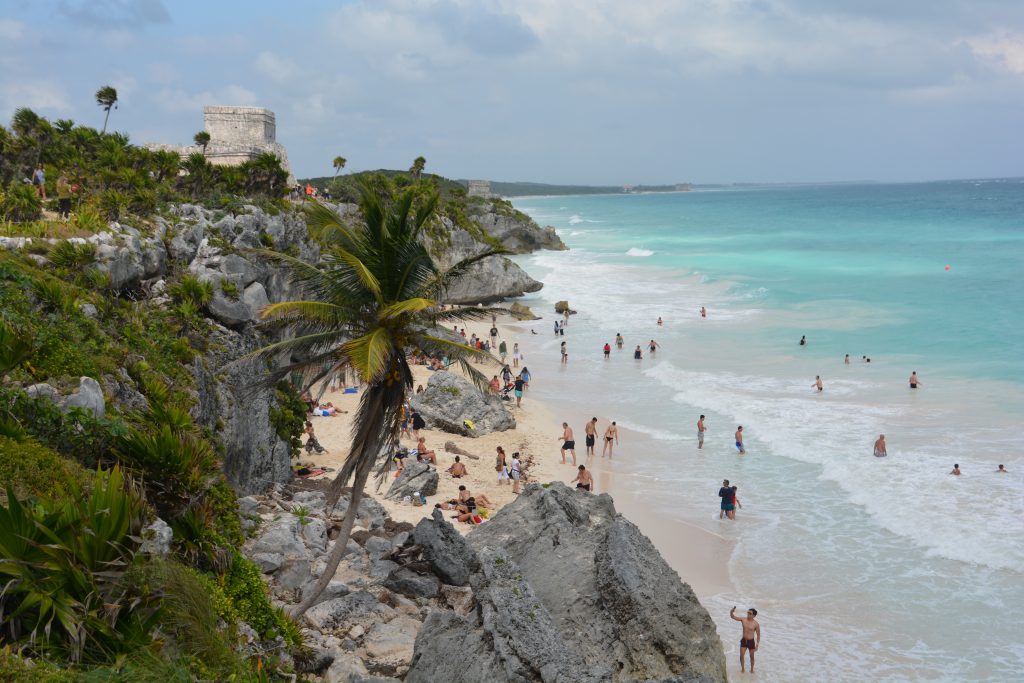
Most of the locals paid their money, had a passing glance at the ruins and then headed straight for the adjoining beach
Further south we camped for our last night in Mexico at the sports field complex in the middle of the town called Felipe Carrillo Puerto. An amazing place, there was a soccer pitch with a game on, an athletics track with many groups training under huge lights well after dark, an indoor gym, an indoor basketball court complex that was used by various groups rotating in and out at the top of the hour and a substantial baseball diamond with spectator stands where a team was training. It was great fun watching all the comings and goings of people in this fairly obscure town use these public facilities to such an extent.
The next day marked our 250th day on the road, a milestone which we were quietly proud of, and would also mark the fifth country of our journey – the small former British colony of Belize. We headed further south, stopping briefly at the town of Balacar to see the Spanish fort which was built to help defend the coastline and then hit the Belize border.
In all we spent 32 nights in Mexico and loved every one. We managed the language barrier, we survived the alleged dangers of travelling there, we really got into the Aztec and Mayan historical sites, we had many pleasant surprises every day and encountered an endless stream of friendly and helpful Mexicans. Yes, there were too many police and police checks, there were a few too many attempted (or successful!) scams and we hated the topes (speed bumps) but we already have plans for returning to Mexico in a couple of years and exploring more of this surprising country. Hasta la vista, Mexico!!
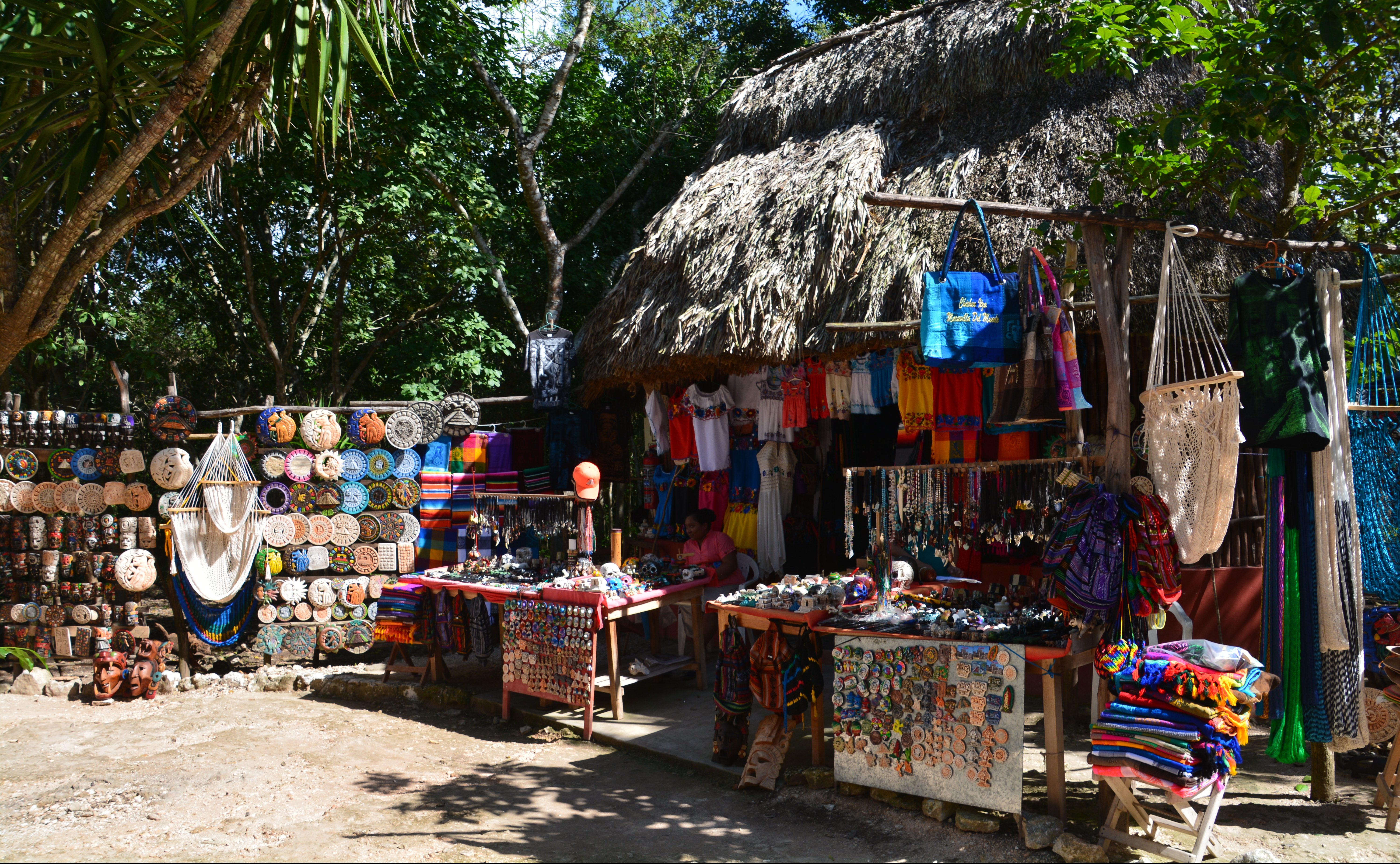









Comments
Adios Mexico — No Comments
HTML tags allowed in your comment: <a href="" title=""> <abbr title=""> <acronym title=""> <b> <blockquote cite=""> <cite> <code> <del datetime=""> <em> <i> <q cite=""> <s> <strike> <strong>